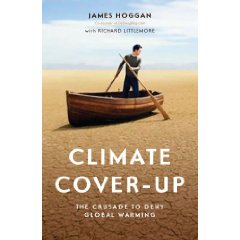Book Review: Climate Cover-Up by James Hoggan and Richard Littlemore
Posted by keith on November 3rd, 2009
I want to say this is an unequivocally wonderful book, I really do, and had it not been for a few rather major issues, Climate Cover-Up by James Hoggan and Richard Littlemore would have been right at the top of my reading list recommendations. It’s still in the upper reaches, and I’ll explain later why it’s not near the top; but for now let’s look at the good stuff, and why this is a very important book.
First, and probably most significantly is the small matter of DeSmogBlog, a project and web site that James co-founded, and which has become the de facto repository for investigative work and enlightening documentation with regards to the climate change denial industry. While The Unsuitablog explores the more public facing and insidious side of ethical hypocrisy, DeSmogBlog takes the big boys on head-first, and in many cases is the reason the denial industry is not even more influential than it currently is.
And, yes, “industry” is the proper word for what is driving the denialist agenda; something Climate Cover-Up explains with a clarity that is evident throughout a great deal of the text:
Promoting scientific research or advancing the public understanding of the true state of science appears not to be the priority. The [American Petroleum Institute] strategists, working on behalf of clients in the chemical and fossil fuel industries, are working instead to change the conventional wisdom, irrespective of the science. They are crafting a plan to create grassroots organizations that serve industry goals, regardless of whether the public might share those goals or might spontaneously have risen to fight for those priorities. These industry-funded planners set out to ridicule the Kyoto agreement and to frustrate government efforts to constrain greenhouse gas emissions. They made a plan to overwhelm the media with a steady stream of information that served industry’s purposes and injected “balance” into coverage, whether or not that balance reflected the true state of science.
You can sense the anger in the writing; something that peppers the text, driven partly by a frustration that the “good name” of the PR industry which Hoggan hails from is being tarnished, but also (I suspect via Richard Littlemore) a genuine disgust at the atrocious behaviour of almost everyone who falls under the Climate Denier banner. Much of the language used by the denial industry is utterly transparent; take this example from Chapter Four:
ICE [a coal-funded astroturf] went into small U.S. markets that were heavily dependent on coal-fired electricity and, with advance planning from the D.C. public relations firm Bracy Williams and Company, tested a series of messages, including:
• “Some say the Earth is warming. Some also said the Earth was flat.”
• “Who told you the Earth was warming . . . Chicken Little?”
• “How much are you willing to pay to solve a problem that may not exist?”
I had a pencil constantly at hand while reading this book, and made the following amendments:
• “Some say the Earth is warming. Some also said the Earth was round.”
• “Who told you the Earth was warming . . . scientists?”
• “How much are you willing to risk to ignore a problem that maynotexist?”
Simple, isn’t it? But the big story that Climate Cover-Up tells is of the sheer volume of disinformation and number of bodies that the denial industry has been able to muster in order to put forward a point of view that runs entirely counter to the scientific body of evidence. Scientists are trusted; politicians and corporations are not — so what did the denial industry do to correct this inconvenient cultural glitch? They manufactured a blizzard of pseudo-science and politicised jargon, forwarded by a battery of “authority” figures, so compelling in its entirely that both the political mainstream and the general public swallowed it and savoured its comforting taste: none of this bitter Climate Change nonsense for them.
The activities of “authorities” like Timothy Ball, Steven Milloy and “Lord” Christopher Monckton (who is wonderfully taken apart in Chapter Nine) are shown as little short of genocidal, given the lives that will undoubtedly be lost as climate change takes hold of the global ecosystem. Timothy Ball, out of all of the Junk Scientists, is the one that, upon reading about him, fired my anger most of all. The totality of his devious activities is brilliantly exposed in Chapter Eleven:
Everything that [Professor Dan] Johnson had said was easily subject to the libel defense of truth. There really was a long parade of highly respected climatology Ph.D.’s before Ball came along, and Ball had not been a professor for twenty-eight years. In fact, twenty-eight years before his retirement in 1996, Ball was still pursuing his bachelor’s degree at another university. Yet the Friends of Science front man had been advertising himself hither and yon as the first climatology Ph.D. in the country and had said in public and on Web site biographies that became part of Johnson’s statement of defense that he had been “for 32 years a Professor of Climatology at the University of Winnipeg.” Ball even wrote a letter to then Canadian prime minister Paul Martin in which he said, “I was one of the first climatology Ph.D.s in the world”. He signed that letter, “Dr. Tim Ball, Environmental Consultant, Victoria, British Columbia, 28 Years Professor of Climatology at the University of Winnipeg.” (And no, the “32 years” reference was not a typographical error, at least not here. Ball used different years in different biographies.)
You would think someone who had been so casual in remembering the details of his career would be reticent to pick a fight over those details. But perhaps Tim Ball thought that Dan Johnson would, like Justin Lancaster, look at the cost of defending himself and choose instead to apologize and retract his criticism. There was certainly pressure to do so. The administration at the University of Lethbridge made it clear that they would offer no assistance with Johnson’s defense, and his colleagues were silent while he took the heat.
Given the anger that Climate Cover-Up undoubtedly creates, you would expect either an utterly radical set of measures be proposed by the authors, or that they would leave it at that and let the reader decide what to do with this inflammatory information. Unfortunately, this is where the book falls down rather badly. Given all that has come before, the final two chapters are infuriatingly weak, and in some cases are actually counterintuitive; for instance:
Together, all [the] polls seem to indicate the following: people don’t trust business; they don’t trust government; and on issues of sustainability at least, half the people don’t even trust one another. No wonder so few people are struggling to make a large personal contribution in the battle to limit the effects of climate change: nobody wants to be a chump. Nobody wants to be the only person on the block who is spending money to repower their heating system. No one wants to give up their car, change their diet, or limit their consumption if their efforts will be rendered irrelevant by the consumption patterns of those around them.
It’s pretty clear to anyone who reads Climate Cover-Up that big business is not to be trusted, and neither are most politicians, given their willingness to take funding from the selfsame industries that are destroying the planet: that is the nature of the beast, and the way Industrial Civilization works, and no encouraging words will change that. The system itself is incapable of doing what is right; which is why when I see phrases like “No one wants to give up their car, change their diet, or limit their consumption”, I get so frustrated — yes I do want to change, and am doing so, despite what others have been brainwashed into thinking, because it’s the right thing to do. Even worse than this, is a statement that turns up in Chapter Seventeen, one that made my blood boil, and not in the way the authors intended:
Sometimes, the most aggressive people in environmental organizations have contributed to that image. Sometimes in moments of frustration or desperation, they have chained themselves to trees or smashed their ships into whaling vessels, adding to the image of environmentalists as inherently radical.
Yes, it’s called passion, and it’s those passionate people who actually create change: not the sheep walking around with banners and petitions calling for “political strength” and “hope”, but those who are willing to stand up directly against the offenders and do what they can to prevent harm to that which sustains all of us. Who wouldn’t, given the nature of the threat?
In the same way, I do not accept the viewpoint put forward by Hoggan, that somehow everything will be okay providing “our leaders” can be persuaded to do the right thing. The implied view that we should look up to people and accept their leadership, while at the same time decrying their culpability is logically flawed to say the least, as exemplified by this statement from the last chapter:
We have to get informed, and we have to get active. Because if we don’t, if we don’t all take the initiative and demand of our leaders that they start fixing this problem, beginning today, it will indeed be a crime. And the punishment will be visited on our children and on their children through a world that is unrecognizable, perhaps uninhabitable.
The act of exposing hypocrisy in the open; encouraging and using the products of confidential leaks and hidden information, and fundamentally knocking down the images of the rich and powerful is far more radical than any of the suggestions for “action” proposed at the end of the book. As I suggested earlier, had the authors decided to leave the stage at Chapter Fifteen, and let the reader use his or her nascent anger in a constructive way, then the book would have achieved, what I presume was its aim: to create change.
Like their contemporaries, Naomi Klein, Ben Goldacre and George Monbiot; Hoggan and Littlemore have produced a cracking book that, while it may not actually fix anything in itself, provides a valuable lesson about a noxious set of practices — practices that still persist, but which now can be better understood and suitably dealt with. Use this as an ideal primer in the world of Climate Change Denial, but choose your own actions: it’s your world.






September 1st, 2010 at 6:49 am
[…] “Hoggan and Littlemore have produced a cracking book that, while it may not actually fix anything in itself, provides a valuable lesson about a noxious set of practices — practices that still persist, but which now can be better understood and suitably dealt with. Use this as an ideal primer in the world of Climate Change Denial, but choose your own actions: it’s your world.” KEITH, Unsuitablog […]